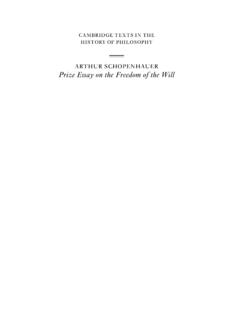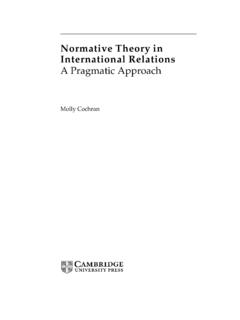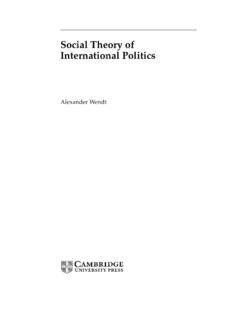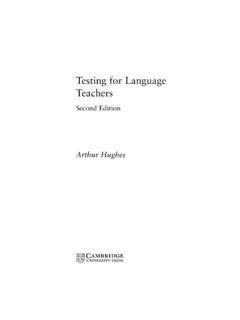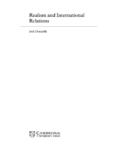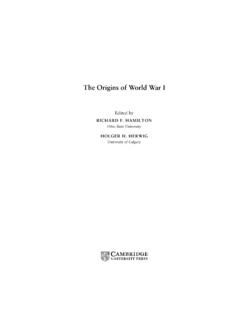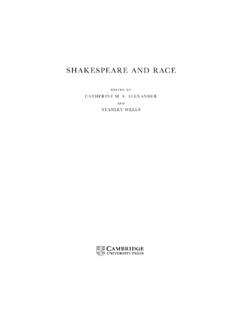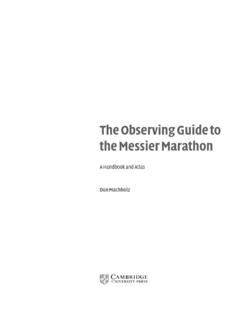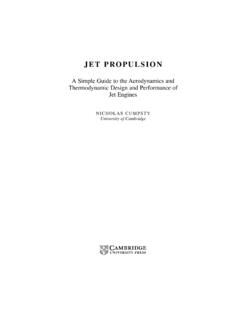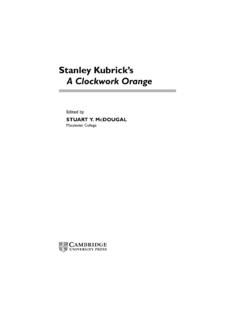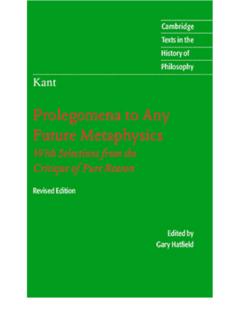Transcription of CAMBRIDGE TEXTS IN THE HISTORY OF PHILOSOPHY
1 CAMBRIDGE TEXTS IN THEHISTORY OF PHILOSOPHYGIORDANO BRUNOC ause, Principle and UnityCAMBRIDGE TEXTS IN THEHISTORY OF PHILOSOPHYS eries editorsKARL AMERIKSP rofessor of PHILOSOPHY at the University of Notre DameDESMOND M. CLARKEP rofessor of PHILOSOPHY at University College CorkThe main objective of CAMBRIDGE TEXTS in the HISTORY of PHILOSOPHY is to expand the range,variety and quality of TEXTS in the HISTORY of PHILOSOPHY which are available in English. Theseries includes TEXTS by familiar names (such as Descartes and Kant) and also by less well-known authors. Wherever possible, TEXTS are published in complete and unabridged form,and translations are specially commissioned for the series. Each volume contains a criticalintroduction together with a guide to further reading and any necessary glossaries and textual apparatus. The volumes are designed for student use at undergraduate and post-graduate level and will be of interest not only to students of PHILOSOPHY , but also to a wideraudience of readers in the HISTORY of science, the HISTORY of theology and the HISTORY of a list of titles published in the series, please see end of BRUNOC ause, Principle and Unitytranslated and edited byrobert de luccaDuke UniversityEssays on Magictranslated and edited byrichard j.
2 BlackwellSt Louis Universitywith an introduction byalfonso ingegnoUniversity of Florencepublished by the press syndicate of the university of cambridgeThe Pitt Building, Trumpington Street, CAMBRIDGE cb2 1rp, United Kingdomcambridge university pressThe Edinburgh Building, CAMBRIDGE cb2 2ru, United Kingdom 20th Street, New York, n y 10011-4211, USA Road, Oakleigh, Melbourne 3166, Australia CAMBRIDGE University Press 1998 This book is in copyright. Subject to statutory exception and to the provisions of relevant collectivelicensing agreements, no reproduction of any part may take place without the written permission ofCambridge University published 1998 Printed in the United Kindom at the University Press, CambridgeTypeset in Ehrhardt 11/13 [cp]A catalogue record for this book is available from the British LibraryLibrary of Congress cataloguing in publication dataBruno, Giordano, 1548 , principle, and unity/translated and edited by Robert de Lucca.
3 Essays on magic/translated and edited by Richard J. Blackwell. A general account of bonding/[all three written by] Giordano Bruno; with an introduction by Alfonso cm. ( CAMBRIDGE TEXTS in the HISTORY of PHILOSOPHY )Includes bibliographical references and 0 521 59359 x(hardback). isbn 0 521 59658 0(paperback)1. Metaphysics Early works to 1800. 2. Magic Early works to 1800. i. Lucca, Robert de. ii. Blackwell, Richard J., 1929 .iii. Bruno, Giordano, 1548 1600. Essays on magic. Bruno, Giordano, 1548 1600. General account of bonding. 1998. v. Title. vi. 1998195 dc21 98 15503 cipisbn 0 521 59359 xhardbackisbn 0 521 59658 0paperbackContentsIntroductionpageviiChr onologyxxxFurther readingxxxivNote on the textsxxxviCause, principle and unity1On magic103A general account of bonding143 Index177 IntroductionGiordano Bruno was born in Nola, near Naples, in 1548. He entered theDominican Order and, following publication of some works that are nowlost, he left Italy in 1579for Switzerland, France and eventually England, amove perhaps due to the oppressive climate in his own country, where thechurch felt itself threatened by the new science which he attempted to prop-agate.
4 Having acquired a great interest in Ramon Lull ( 1316)1andthe art of memory, he presented in London his vision of an infinite universein which he sought to re-unify terrestrial physics with celestial physics onthe basis of a principle of universal becoming. He also reflected on the causesof the religious wars and tried to determine the origin of the theological dis-putes of the period. Beginning with the metaphysics expressed in De lacausa, principio e uno (Cause, Principle and Unity), which reflected the objec-tions he encountered in England, he derived a new concept of the divinitywhich evolved from his cosmology and was to assume a radically anti-Christian character. The magical, animistic vision of everything which headopted throughout all his writings, not just those of the last period of hislife, is evident here. In addition to his specific contributions to the scientificrevolution, he presented a general metaphysical vision that contributed sig-nificantly to the development of Renaissance returned to Italy in 1591during the debate about the legitimacyof combining ancient knowledge with orthodoxy, Bruno was perhapsdeceived by the experience of Francesco Patrizi,2who was lecturing invii1 Lull designed an ars combinatoria, a code for representing reality such that its elements could be com-bined in diVerent ways to represent various items of knowledge, from astronomy to theology.
5 Masteryof this code and its permutations provided the person trained in its use with a sophisticatedmnemonic Patrizi (1529 97) was one of the leading Platonists of the Renaissance; his major work, ANew PHILOSOPHY of the Universes, was condemned by the Congregation of the Index in PHILOSOPHY at the University of Sapienza at Rome. He thought hemight be able to find a role for himself by renouncing or concealing themost heterodox features of his own teaching. This was an illusion, and hefell foul of the Inquisition and was executed at the stake in the Campo de Fiori in Cena de le Ceneri(The Ash Wednesday Supper) was the first of the dia-logues in Italian which Bruno published in 1584 striking featureof this work, in which the author proclaims his Copernicanism, is theimmediate connection established between the annual motion of the eartharound the sun and the infinity of the universe.
6 This, however, was quitediVerent from the position of Copernicus, who, having given new dimen-sions to the traditional cosmos, recognized the immensity of the heavensbut left to the natural philosopher the ultimate decision about whether ornot the universe was infinite. In The Ash Wednesday Supper, on the con-trary, we find a clear aYrmation of an infinite universe with infinite solarsystems similar to our own. Suns and earths are composed of our own elements, they are living and inhabited beings, they are stars which are recognized not only as living things but also as was led to these conclusions, in particular the thesis of the infin-ity of the universe, by a number of factors. In Copernicus work, the earthwas construed as a celestial body rotating round the sun like the other plan-ets; it was implicitly elevated to the status of a star, thus breaking down therigid separation between the sublunary world and the celestial world,although Copernicus did not want to confront the enormous physicalproblems which derived from his heliocentrism.
7 It is significant that, in hisDe revolutionibus orbium celestium(On the Revolutions of the HeavenlyBodies), the sphere of fixed stars no longer had a specific physical functionand no longer constituted the principle of motion. This was a conclusionthat could have been strengthened in Bruno s eyes by some developmentsin Italian PHILOSOPHY of nature, especially those of Bernardino Telesio(1509 88). Bruno now went further and called into question the very Introductionviii3 References to Bruno s Italian works are in the Dialoghi italiani, 3rd edn edited by G. Aquilecchia,reprinted with notes by G. Gentile (Florence: Sansoni, 1958: reprt. 1985). The Latin works, Operalatine conscripta, were edited in Naples between 1879and 1891in three volumes (in eight parts) by , F. Tocco, G. Vitelli, V. Imbriani and C. M. Tallarigo. References to the Latin works areidentifed as Op.
8 Lat., with the volume, part and page of such a sphere, which seemed to him merely the result of anoptical illusion which made all the stars appear to be at an equal distancefrom the s comparison between himself and Copernicus in The AshWednesday Supperthrows further light on this issue. Although Copernicusis ranked in the HISTORY of astronomy as being comparable to Hipparchusor Ptolemy, his real significance is thought to lie in the fact that he is a heroof human thought who was able to oppose the force of common prejudice,the vulgar Aristotelian PHILOSOPHY , the apparently self-evident view thatthe earth was immobile in the centre of the heavens. Nevertheless, his workis presented as having crucial limitations which open the way to what willbe Bruno s specific contribution. Copernicus was primarily a mathemati-cian his interest was directed towards astronomy rather than towards nat-ural PHILOSOPHY , and in this sense his work needed to be further he started from a correct and significant physical presupposition,the earth s motion, but he sought only a mathematical description of themovements of the contrast, Bruno presents himself as a natural philosopher, as the onewho is destined to become the authentic interpreter of Copernicus dis-covery and is called to draw out the conclusions from it, beginning with thephysical ones.
9 The first of these, which is decisive for a correct under-standing of the others, is the infinity of the universe. In the NarratioofGeorg Joachim Rheticus, which Bruno was able to read in the 1566editionof De revolutionibus, Rheticus had described the astronomer as a blind manwho has a stick to help him on his way, and this stick was mathematics. Inorder to accomplish the theoretical task which he sets himself, a task whichlies at the limit of human ability, the astronomer needs a hand to guide himand inspiration from above. Thus in The Ash Wednesday SupperCopernicusbecomes the inspired one to whom the gods have entrusted a message, theimportance and significance of which he has not realized; he is like a blindfortune teller for whom Bruno acts as the authentic interpreter. Thephilosopher, therefore, is summoned on a metaphorical journey across theheavens to discover that the traditional crystalline spheres are only a vainfiction, that there is no upper limit to the physical world and thus no endto his journey, and that what opens out in front of him is an infinite philosopher shows us that the divinity is present in us and in ourplanet no less than in every other heavenly body, that it is not situatedixIntroduction4 Dialoghi, 26 the imaginary limit of a closed and finite universe, in a place whichmakes it accessible to s reform, therefore, is not only philosophically significant but alsohas religious consequences.
10 It challenges the developments of theReformation, calls into question the truth-value of the whole ofChristianity, and claims that Christ perpetrated a deceit on mankind. Inthe pages which follow, he compares the negative consequences which haveresulted from traditional PHILOSOPHY negative consequences which areapparent to everyone with the positive fruits, both civil and religious,which the new PHILOSOPHY is producing, revitalizing all those fields ofknowledge and life in which the ancients had consequences of this new PHILOSOPHY are wide-ranging and radicalbecause this new vision of the cosmos changes our relationship with thedivinity, and this, in Bruno s eyes, transforms the very meaning of humanlife. He claims that this new vision will reconcile us with the divine lawwhich governs nature, and free us from the fear of imaginary divinities,cruel and unfathomable, who look down from heavenly heights, control-ling the sublunary world in a mysterious way.
